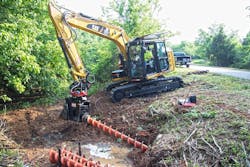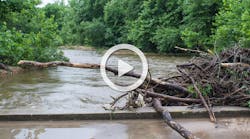Clearing Culverts
Road and highway departments battle water runoff, which causes traffic issues and dangerous road conditions. Water can cause erosion of the surrounding roadbeds and eventually can destabilize the road’s substructure, causing potholes and sinkholes. Seasonal rains and heavy snows contribute to this problem by bringing sand, dirt and debris along with them to clog culverts and make drainage nearly impossible.
RELATED: Catching Up on Culvert Repair
Problem Solving
Recently, the Alabama Department of Transportation (DOT) in Montgomery, Ala., was introduced to a new mechanical system to help with culvert cleaning.
Ballast Tools Equipment (BTE) and its engineering team worked with several of its railroad customers to engineer a powerful mechanical method to clean culverts and drainage systems under railroad tracks. BTE engineers designed an auger system that is attached to the end of an excavator boom and stick. According to Matt Weyand, BTE sales engineer, the BTE Culvert Cleaner System uses 5- and 10-ft-long steel auger sections to clear clogged or impaired culverts and pipes.
The system’s drive box has a high-torque, low-speed sealed drive that can operate underwater in a flooded environment. A camera system allows the operator to view the progress at a safe distance from the drainage cavity. The Rototilt system on the Caterpillar excavator gives the system the ability to rotate 360 degrees and tilt to 40 degrees for proper insertion into the cavity. Officials at the state and local levels agreed to a demonstration of the system on one of their more troublesome culverts in northern Alabama.
Testing the Culvert Cleaning Tools
According to a state of Alabama employee, a certain culvert had not flowed in years. The box culvert was approximately 24 ft wide and 4 ft deep, with a concrete structure floor, top and sides.
The BTE team knew it had an opportunity to prove the system’s value with the Alabama DOT to solve this long-standing issue that had the potential to become a traffic safety hazard.
The initial assessment of the site made it clear to Ned Williams, president of BTE, that they needed to add some extra tooling to the end of the auger.
“We were told that the main issues were suspected limbs and trees restricting flow somewhere near the middle of the four lanes, so we decided to attach one of our cutter head bodies to the end of the lead auger,” he said.
Working underwater, it was difficult to tell what was being pulled out from the augers until the drive head started to raise out of the stained water. As the day wore on and the sun beat down, more than 120 feet of augers, used as a culvert cleaning tool, had been inserted into the culvert without breaking through to the other side.
“I just let the augers continue to work inside the culvert,” Weyand said. “We were moving a lot of material out of the culvert, then I felt like we hit something hard impeding our forward progress. I worked the augers back and forth adding more force, when, finally, something let loose and water started flowing.”
Unknown to anyone, there had been a partial collapse of the culvert on the eastern side of the highway. As water and debris started flowing out of the now partially cleared drainage culvert, Weyand and an Alabama DOT operator worked in tandem to clear the debris from the west side lagoon. When the drive box would raise up due to the material being removed, a support excavator would scoop out and dump the debris that accumulated at the culvert exit end. Old asphalt, concrete, wood, trash, rocks and dirt all came out into the pile.
How are Culverts are Cleaned?
Williams said he felt that the demonstration had proved itself clearly to the state of Alabama engineers in attendance.
“We were prepared for a beaver dam, and we got concrete,” Williams said. “The BTE Culvert Cleaner System did what we set out to do. I don’t believe there could have been another way to clear this culvert in a short period of time like we did.”
Previously, attempted culvert cleaning involved some creative methods, such as running steel poles into the culverts, dragging chains and tires, installing water-jet systems and driving a skid steer loader into the larger culverts.
The BTE system drives augers into the culvert opening from one side, allowing the augers to work through the top of the impacted material. The 10-ft auger sections are carefully screwed into the culvert, and more augers are attached until the other side is reached. Once the augers are through the culvert, the weight and force of the rotating augers work down through the clogged areas, and the material is ejected out of the culvert with little or no damage to the culvert itself.
The system’s demonstration in Alabama was one of several that Williams, Whittington and Weyand have completed for states and counties in the southeast U.S. Many highway and road departments face similar issues as the Alabama project.


